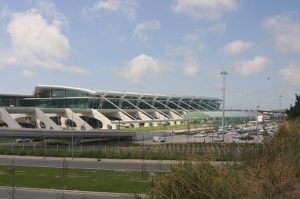Porto Airport
The Francisco Sá Carneiro Airport, also called Porto Airport (formerly Pedras Rubras Airport) (IATA code: OPO; ICAO code: LPPR) is located in Greater Porto, in the confluence of the municipalities of Maia, Matosinhos and Vila do Conde, in Portugal. It is currently the Portuguese airport with the largest catchment area.

In 2007, Francisco Sá Carneiro Airport was awarded the best in Europe in the category of airports up to 5 million passengers.
It was inaugurated in 1945 as Pedras Rubras Airport. Until then, the city of Porto was served, in terms of air transport, by the Espinho aerodrome, built in 1935 by the Military Aeronautics.[lack of sources]
The airport was inaugurated on December 3, 1945 with a flight from Lisbon by an aircraft of the Companhia de Transportes Aéreos. The first international flight took place in 1956 and four years later a regular flight service to London was started.
In 1975, as demand for the porto airport grew, the runway was extended to 3480 meters. A cargo terminal was opened in the mid-1980s. In 1990, a new terminal was inaugurated with a capacity for 3 million passengers per year, and the designation of the facilities changed from Pedras Rubras Airport to Francisco Sá Carneiro Airport[5] In this way, the Prime Minister Francisco Sá Carneiro, who died on 4th December 1980 in a plane crash in Lisbon while travelling precisely to Pedras Rubras, was honoured. In 2000, with the rapid development and increase in passenger traffic, the airport reached a situation very close to saturation, which led ANA to decide on an ambitious development project. Thus the ASC 2000 plan was drawn up as a guiding framework for all future interventions. This plan included the construction of a new access viaduct, new parking areas, a new terminal with 9 direct access maneuvers to the aircraft, new taxiways, new aircraft parking positions and remodeling of the cargo terminal. The airport was designed to be easily expanded. Thus, responding to the increase in passenger numbers, the airport will see its capacity increase from 12 to 15 million passengers/year, and from 15 to 20 million passengers/year in the future.
The airport consists of a runway with headlands 17/35, 3 480 m long and 55m wide asphalted, with the runway lines being 45m wide.
It is currently the best airport in Portugal in terms of terminal space. In terms of cargo and passenger air movements, it is the second largest in Portugal (ahead of Faro and behind Lisbon). This modern airport has witnessed a large increase in passengers and flights, and its destinations are also increasing, especially at European level thanks to several low cost airlines, namely Ryanair (which may soon overtake TAP Air Portugal in passenger numbers). Ryanair announced, on July 4th, 2009, the opening of its 33rd base, at Francisco Sá Carneiro Airport, in an investment of more than 140M$, making history as the first foreign company to “establish itself” in this infrastructure with two permanent aircraft… Ryanair connected, for the first time, Porto to Faro, in a regular and direct way, on October 26th, 2009. On June 14, 2010 Ryanair announced the purchase of the third aircraft for the Oporto base as well as the creation of seven new routes: Barcelona El Prat, Bologna, Bremen, Maastricht, Marrakesh, Munich West (Memmingen) and Valencia. On July 2, 2019, Emirates started a regular flight service between Porto and Dubai, four times a week, opening doors to Asia and Australia.
4470-558 Vila Nova da Telha, Portugal
